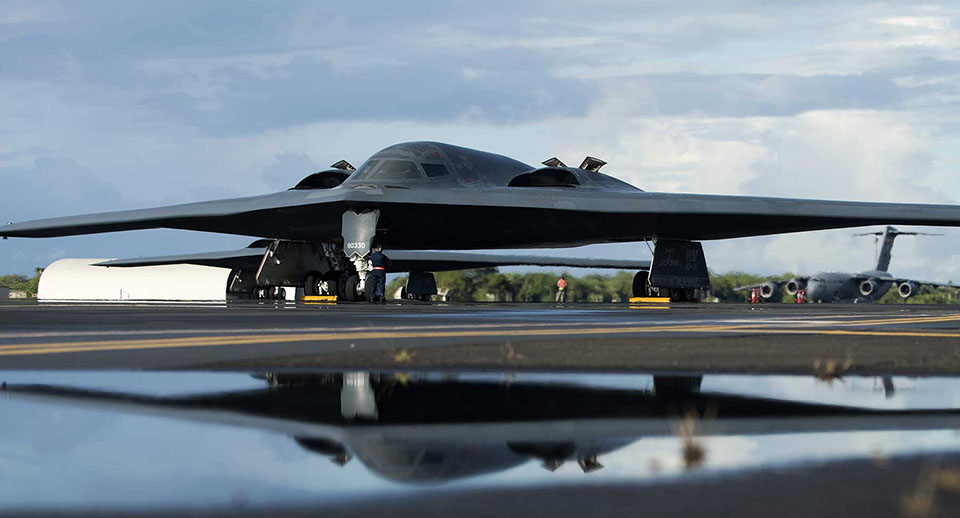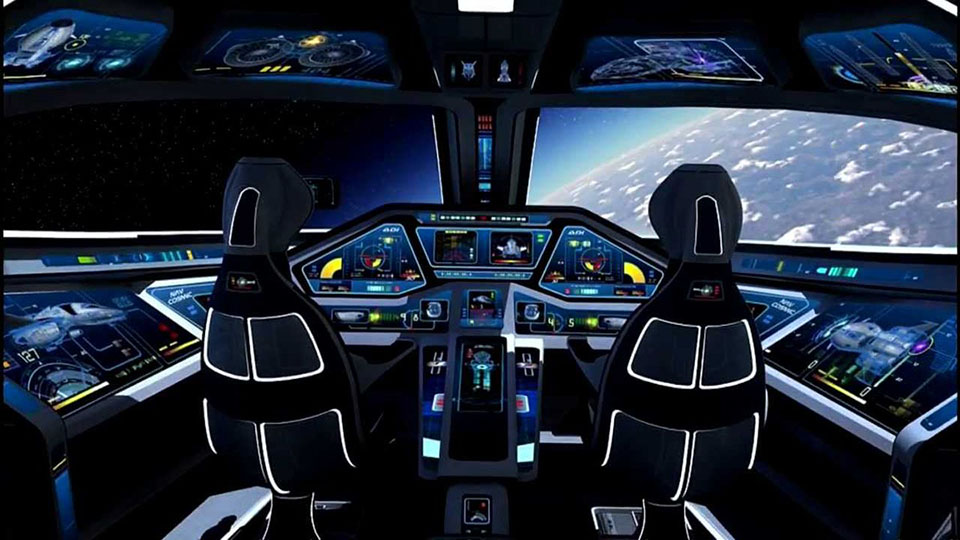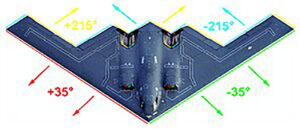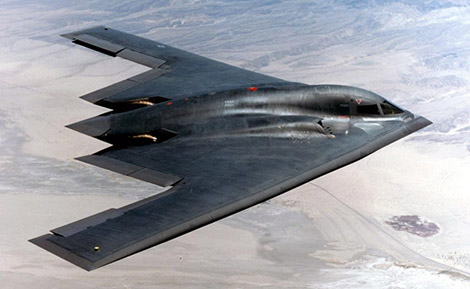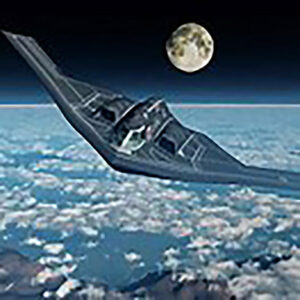How does this aeroplane fly? It doesn’t have a rear tail assembly. Nor is it cigar-shaped like all the other aeroplanes that I have ever seen, or, travelled on. It’s more like a flying wing. What makes this design so different to other traditional designs of aircraft that we have grown up with? Who owns such a plane, and what is it used for? So many questions ran rampant throughout my mind. I had to investigate further. What I discovered, (that wasn’t military classified), was amazing.
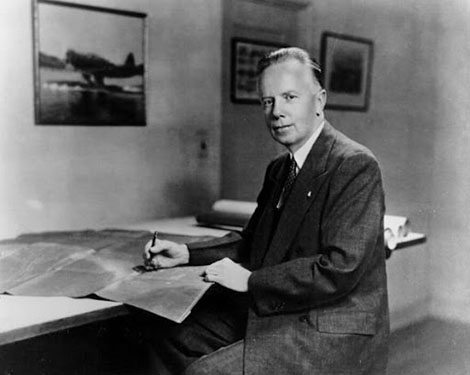
In the early 1940’s, one man’s radical vision (Jack Northrop). dreamed of creating a flying v-wing bomber for the United States Government, who were yet to enter The Second World War. It took until 1980, just before Northrop’s death, U.S.A.F. gave him an invitation to a top secret classified base to witness his dream come true. He was shown a scaled-up model of the B2 Spirit flying wing. The B2 Spirit (Strategic Global Nuclear War Deterrent Bomber) Jack was quoted “I was kept alive all these years for a reason, here it is.” As he cried! Northrop’s vision had come to life. Modern autopiloting technologies and turbo fan jet engine vectoring, enable the flying wing to correct in real flight time, yawing issues that caused platform failures, were now a thing of the past!
It’s indeed a computer-based, augmented autopilot system that is standard military equipment on today’s flying weapons platforms, and most civilian aeroplanes. Northrop’s dream was never possible during his lifetime of aviation
WHAT IS ENGINE VECTORING?
Vectoring of turbo fan jet engines allows the pilot to point all of the engines exhaust nozzles in a certain direction. The high thrust assists in turning the plane into the desired direction. (I.E., yawing) and thus minimizing the use of up or down movements of the allerions, further enhancing the plane’s ability to avoid radar detection.
Imagine it turning, from left to right, up, down, and side to side at all degrees, in unison with the other available jet engines on the platform. Then you have a huge amount of instantaneous computer-controlled power in which to change your flight direction! Its astonishing that it only took 40 years to develop this technology. Jacks wing had been taken into the future, which is now! The Strategic B2 Spirit Stealth Bomber!
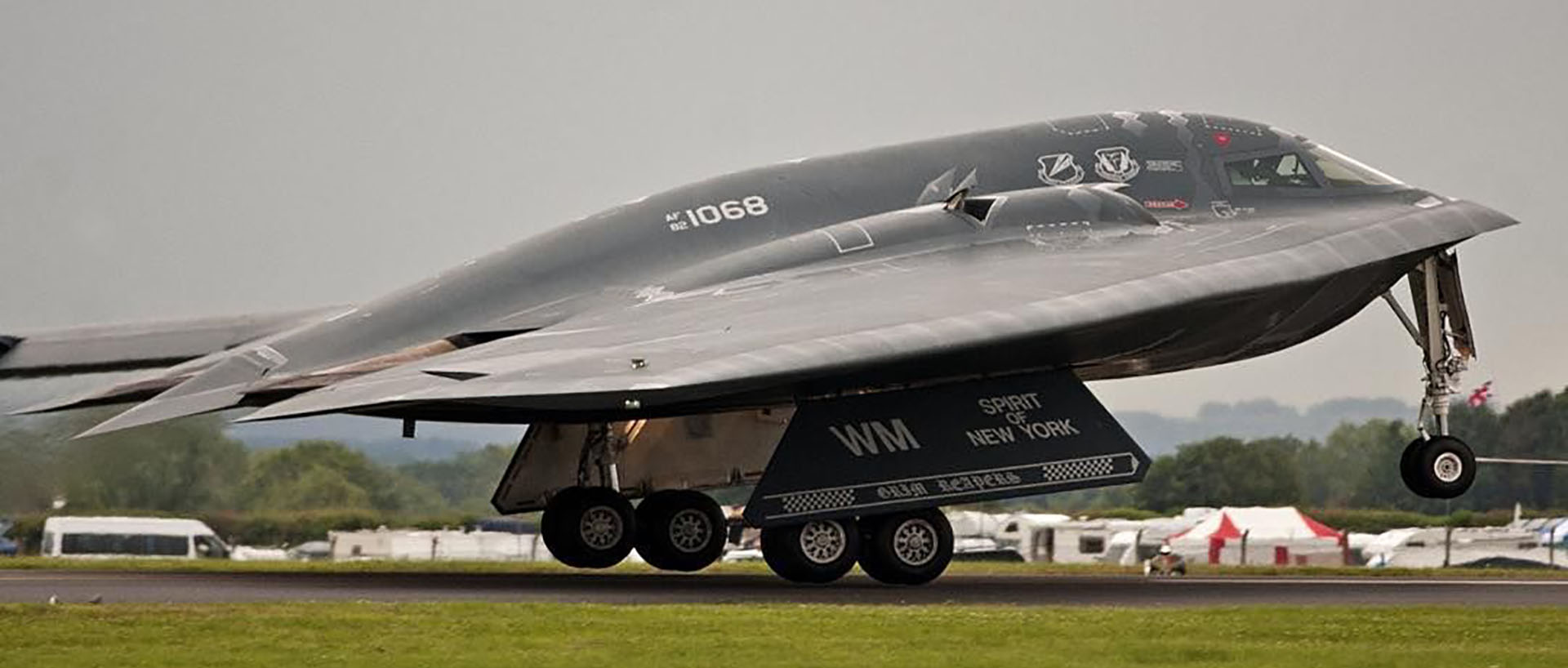
Most of the technologies used on the B2 Stealth aircraft are still classified.
However, what I will endeavour to present is a picture of what this aircraft is, what it is used for, and why? I have researched the available data both online and in literature to provide as accurate a description as possible, given the secrecy that shrouds this flying weapons platform. Whilst the aircraft is on the ground, she weighs in at around 72 tonnes (Empty), with a wingspan of 52 meters. The absorbing paints and materials used to coat the outer structure of the plane remain classified, so we really don’t know how it evades radar signals, to remain virtually invisible, to friend or foe detection, whilst airborne and heading towards potential hostile targets. What we do know about the design is that it has many continuous rounded surfaces that reflect current radar detection systems. The United States Airforce call this “continuous curvature.” Air speed, temperature, and angle of attack censors are all smoothly embedded into the B2’s airframe. To have a traditional airspeed sensor probe extending from this bomber’s fuselage, would render the B2 ability to remain invisible, obsolete. If a traditional cigar-shaped aircraft with a wingspan of 52 meters, with either 2 ,4, or 8 jet engines attached under them, with a 10–15-meter rear tail wing assembly, their radar signature (above picture), would be immediately detected. With the B2 spirits design, the signature emitted resembles that of a large bird of prey. All the angles and panels on the plane are designed to reflect the radar waves away from the emitter.
Please note the figure below that we have been able to acquire. It shows the reported angles that tracking radar wave frequencies are reflected from the aircraft so as to protect its true identity.
- The leading front edges of the aircraft are curved at angles of plus and minus 35 degrees
- The two side and rear wing edges at curved at angles of plus and minus 215 degree.
These curvatures are said to assist in its stealth capabilities Looking at the end of the wing sections, we notice that there is no flaps or wing extensions that traditionally designed aircraft use. Due to the size of the entire wing, it produces enough uplift so, wing slats are not required. From the pictures you will also notice that the plane has no winglets or horizontal stabilisers or rudders at the rear. Any vertical structures on the B2 would emit radar waves to any would be tracker. On the outer trailing edge of the wing, engineers have placed split rudders in order to give pilots control of the aircrafts yaw, whilst in flight. Remember, yaw is what enables the plane to move from side-to-side inflight movement. However, the slightest of rudder elevation up, or down, increases the aircrafts radar detection signature, putting it at risk. So, pilots have been trained to an acute high standard to further reduce detection from a hostile adversary. The B2 Stealth bomber can also use a technique called engine thrust vectoring, (refer to page 9), further eliminating the need for full rudder movements, further minimizing radar emissions and detection
How can the designers of this aircraft hide the heat signatures that come from the B2’s jet engines?
Heat signatures allow potential enemy missiles to lock on, hence destroying the aircraft and potentially killing the crew
The engines of the B2 are not visible from the ground up. They are positioned higher into the body of the aircraft. The spent exhaust fumes are released though vents on top of the B2, so they can dissipate quickly in the airspace above, as the aircraft moves forward.
This aircraft is powered by 4 General Electric turbofan jet engines. Each produce around 17,300 pounds of thrust. (Note the air intakes circled in red on the picture above). The turbines spinning blades are set well back into the air intakes, adding to the stealth capabilities of the craft. Additionally, flying at high speeds, the air taken in is somewhat turbulent. So, engineers have designed a two-step intake system. The first section redirects most of the air though-out the plane’s fuselage, whilst the remaining calmed air is fed directly into the turbines. This is not the end of the air intake system. The initial recirculated colder air that travels through pipes within the fuselage, is refeed back into the engines super-heated exhaust gases before they are dissipated from the top of the aircraft, over titanium and carbon reinforced surfaces to further assist in the cooling of the exhaust gases. Further enhancing its stealth capabilities.
Research has indicated the B2’s 4 engines do not allow it to fly at supersonic speed. (Faster than the speed of sound). By breaking the sound barrier (767 m.p.h. or 1,234 k.p.h.), would give away its position. However, it has been suggested it is capable of speeds of up to Mach 2.4 or faster. (2,400 m.p.h. or 3,862 k.p.h.). These engines do not come equipped with afterburner technology, so as to assist the pilot’s available engine power (thrust). To give such an aircraft this capability, would render it to detection, especially when applied during night flying. Large flames emitted from the afterburning engine would render the B2 to detection. The increased heat from afterburner usage would also increase its visible infra-red heat signature to tracking systems Stealth is its objective, to remain invisible to radar. With state-of-the-art onboard computer censoring, in real-time the pilot can make altitude and directional maneuvering if condensation (contrails) is detected. The last thing that a stealth bomber needs is the tell tail white lines painting the sky, that leads directly to the aircraft.
The Radar Absorbing Materials (R.A.M.) coatings that are applied to B2’s airframe?
Along with the radar eluding curves built into the airframe, we really cannot tell you what the actual composition of the R.A.M. consists of (Highly classified). I speculate, the paints and panels used have a high concentration of ionised particles and carbonised based materials and coating. All are believed to absorb radar waves. These surfaces are highly fragile and require a ground-based team of highly trained specialist personnel to maintain and store these aircraft in highly regulated climate, temperature, and humidity-controlled hangar After every flight, the airframes are meticulously checked for the slightest of damage, including scratches. As any defect on the flying surface would comprise the planes stealth capabilities. This is one of the reasons why no other country in the world possesses, or plan to pose such bomber capabilities. Maintenance per month (2018) was estimated at $5.25 million US dollars per plane. With 20 planes active in the fleet, the bills soon mount up. In todays adjusted money, The U.S. taxpayers were initially billed $1.2 billion per plane to build, then adding in research and development costs of $2.3 billion the total cost came to $3.5 billion U.S. dollars for each B2 bomber. Initially 22 bombers were acquired by the U.S.A.F. Two have since crashed, (technical fault and the other pilot error).
The first flight was in July 1989; 33 years ago. The U.S.A.F. started taking deliver from Northrup-Grumman in January 1997. The total number built 22. The biggest known weakness to date? In hindsight, so few were made. With the collapse of The Soviet Union from 1989 to 1992, The Pentagon no longer saw the need for the original estimates of 150 to 200 Bombers. The threat of Nuclear War had receded for the time being. Having the capability of all-altitude attack missions, supposedly up to 50,000 feet (15,000 m), given a range of more than 6,000 nautical miles (6,900 miles; 11,000 km) whilst relying solely on her internal fuel capacity. With mid-air tanker refuelling the estimated ranges are up to 10,000 nautical miles (12,000 miles, 19,000 km).
To date, only 80 pilots fly the B-2 Spirit bomber. A crew is assigned to each aircraft, a pilot, sits in the left seat, with the right seat occupied by the mission commander. There is a provision for a third crew member if needed. In comparison, the B-52 has a crew of five. The B-2 Spirit is an extremely automated weapons platform, allowing for one crew member to utilise the toilet when required. Additional onboard facilities enable a crew member to enjoy a hot meal, as the other member monitors aircraft performance and mission parameters. The B2 also has an area in which a sleep-in camp bed is available. The engineering researchers took into account all the advanced research into fatigue and sleep deprivation that could impede the crew’s performance whilst engaged on long range flight missions.
What sort of armaments can these planes carry and how much?
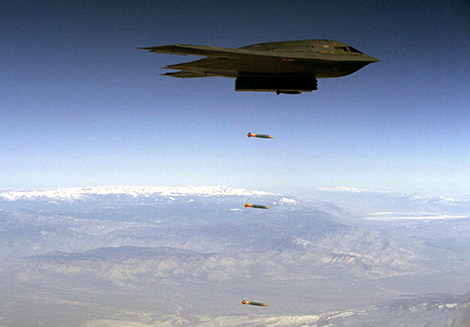
The B2 is equipped with 2 internal bomb bays. Nothing hangs externally from this aircraft. We are told they can hold around 40,000 pounds (18,200 kgs) of conventional high explosive weapons, cruise missiles, (conventional explosive heads and nuclear tipped). Along with the full arsenal of the United States nuclear free-falling bombs. My research seemed to indicate the B2 has a larger capacity, possibly up to 50,000 pounds (22,200 kgs).
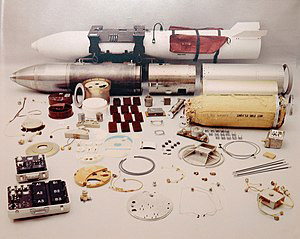
However, the exact amount varies from different information sources! One thing we do know is, the bomb bay doors are opened with extreme speed and the ordinance is released instantly. The doors are then reclosed as fast as possible. Once the doors are opened, the B2’s radar cross section jumps to enormous proportions. Exact size, (classified). However, it momentarily loses its stealth capabilities and becomes visible to radar.
The B2 is not equipped with missile defenses or machine guns. It relies entirely on its stealth capabilities to enter hostile enemy airspace undetected, deliver its assigned weapons payload to its target and successfully return home base safely. To date, this is the world’s most technically advanced weapons platform ever produced on this planet.
So, why are these B2 Spirit Bombers be deployed to Australia for a 3-month period in 2022? (July-September).
Early July 2022, the skies in and around the Royal Australian Airforce Base Amberley, North Queensland were witness to the unprecedented arrival of the United States Airforce’s B2 Stealth Bombers. Being deployed (based) for the first time on Australian soil. The 2 aircraft had flown from their home of Whiteman Airforce Base, in Missouri U.S.A. Their arrival was in support of a Pacific Air Forces Bomber Task Force. This deployment allowed the American aircrews and ground support staff the opportunity to work in with their Royal Australian Airforce (R.A.A.F.) counterparts.
This particular deployment from the 509th Bomb -wing is a part of the two countries governments co-operation under the Force Posturing Agreement. This will enable the air personnel from both countries to assist in conducting strategic training missions from Australian soil. These allied operations also act as missions of deterrent to any possible hostile adversary that wishes to challenge the open and free Indo-Pacific region that has enjoyed peace and prosperity since the end of the Second World War.
Such a deployment to Australia by the joint air forces political masters, displays to our Indo-Pacific neighbours, the ongoing commitment to peace and regional stability.
Currently, the R.A.A.F has the capability to conduct mid-air refuelling of aircraft Given the B2’s deployment that ended in September 2022, it gave the service the opportunity to work in with the B2 bomber crews. Further enhancing allied inter operational readiness. With the further deployment of 2 more B2’s in late July, one fifth of the U.S.A.F. B2 strength will be temporarily deployed at R.A.A.F. base, Amberley. What message are the Governments in the Indo-Pacific region sending to our friends and neighbours within the region?
What message are particular Governments in China and North Korea receiving from such operational ready deployments of strategic nuclear armed B2 bombers? Should we, as members of the peace loving and prosperous Free World ignore the potential hostile threats of military takeovers of perceived territorial ownership, that has its roots buried deep in the past.
Can we allow Communist, Authoritarian regimes to challenge the strength, stability, and peace of this part of our globe? Will rising tensions with The Communist Peoples Republic of China, simmer, after acknowledging the strategic nuclear war deterrent that these geo-political tools that the United States Government and the Free World have at their disposal prevail, along with common sense?
Will our species endure, prosper, and evolve into the next century and beyond?
Can the current Nuclear Deterrent against potential conflict between the Superpowers of the world, be avoided in the Indo-Pacific theatre?
I ponder many a question out loud.
How far have we evolved as the species labelled Human Beings?
Are we in a period of human de-evolution?
Cannot human nature release itself from the miserable yolk of territorial conflict?
How will these current Indo-Pacific tensions end?
Will geo-political peace ever prevail?
John Lennon once wrote lyrically, “All We Are Saying, Is Give Peace A Chance!”
